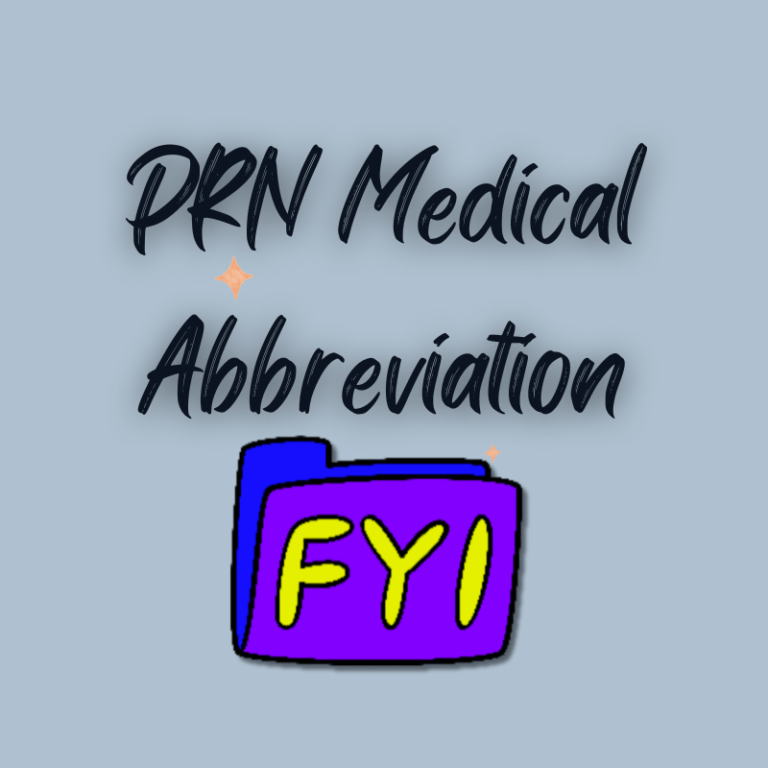Table of Contents
PRN Medical Abbreviation
Medical abbreviations are commonly used in healthcare settings to improve efficiency and communication among healthcare professionals. One such abbreviation you may encounter is "PRN." In this article, we will explore the meaning of PRN and how it is used in medical contexts.
Definition
PRN is an abbreviation derived from the Latin phrase "pro re nata," which translates to "as the circumstance arises" or "as needed." It is often used in medical documentation to indicate that a particular action should be taken only when necessary or when certain conditions are met.
Usage
The term PRN finds its application in various areas of healthcare, including medication administration, dosage instructions, nursing care, and more. It serves as a directive for healthcare providers to provide treatment, medication, or care on an as-needed basis rather than on a fixed schedule.
Medication
In medication administration, PRN is commonly used to indicate that a specific medication should be given to a patient when required. This is often the case when addressing symptoms that occur sporadically or when additional relief is necessary beyond the patient's regular medication regimen. PRN medications can include pain relievers, anti-nausea drugs, or sleep aids.
Dosage
Determining the appropriate dosage for PRN medications is crucial to ensure patient safety and optimal therapeutic outcomes. Healthcare providers carefully assess the patient's condition, consider factors such as age, weight, and medical history, and prescribe a suitable dosage range. The specific dosage within that range is determined based on the severity of symptoms and the individual's response to the medication.
Nursing
In nursing practice, PRN orders are used to guide the delivery of patient care. Nurses follow PRN instructions to provide additional interventions or treatments based on the patient's changing needs or condition. For example, if a patient is experiencing difficulty breathing, a nurse may administer a bronchodilator PRN to alleviate the symptoms.
Benefits
The utilization of PRN offers several advantages in healthcare. It allows healthcare providers to tailor treatment plans to individual patient needs, ensuring that interventions are provided when necessary. PRN also provides flexibility in medication administration, enabling healthcare professionals to respond promptly to changing symptoms or conditions.
Considerations
While PRN can be beneficial, it is essential to consider certain factors when utilizing this approach. Healthcare providers must carefully assess the patient's condition and monitor their response to PRN interventions. It is crucial to strike a balance between providing timely care and avoiding unnecessary treatment or medication administration.
Safety
Patient safety is paramount in the use of PRN. Healthcare professionals must ensure that clear instructions are provided, and proper documentation is maintained for PRN interventions. It is crucial to communicate PRN orders effectively among the healthcare team and educate patients on how to use PRN medications safely.
Conclusion
In conclusion, the medical abbreviation PRN stands for "pro re nata," meaning "as needed." It is used in various healthcare contexts to guide the administration of treatment, medication, and nursing care based on the patient's changing needs. By using PRN appropriately, healthcare providers can ensure patient-centric care while maintaining safety and efficiency.
FAQs
1. What other common medical abbreviations should I be aware of?
- There are several common medical abbreviations used in healthcare, such as QID (four times a day), BID (twice a day), and TID (three times a day). It is important to familiarize yourself with these abbreviations to understand medical documentation effectively.
2. Can PRN medications be addictive?
- PRN medications are generally prescribed in a way that minimizes the risk of addiction. Healthcare providers carefully assess each patient's needs and monitor their response to medication to ensure appropriate usage and minimize potential dependence.
3. Are PRN orders only used in hospitals?
- No, PRN orders are not exclusive to hospitals. They are used in various healthcare settings, including clinics, long-term care facilities, and home healthcare, where patients' needs may change over time.
4. Is it safe for patients to administer PRN medications on their own?
- Patients should always follow healthcare providers' instructions when administering PRN medications. It is essential to understand the proper usage, potential side effects, and any precautions associated with the medication. Consulting with a healthcare professional is advisable.
5. How can healthcare professionals ensure effective communication regarding PRN orders?
- To ensure effective communication, healthcare professionals should document PRN orders clearly, share them with the healthcare team, and provide comprehensive information to patients. Clear communication and documentation help prevent errors and promote patient safety.

Comments are closed.